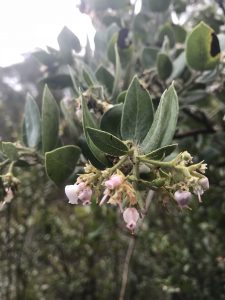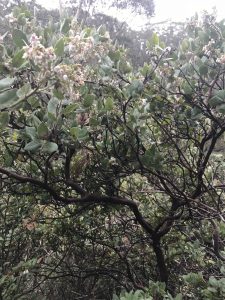Date: 3/1/18
Location: San Pedro Valley, Pacifica 37.5779° N, 122.4757° W, elevation 2388 ft.
Site Description:
Upon arrival, there is open space and picnic benches. We started off on Plaskon Nature Trail which takes us to Hazelnut trail. Immediately into the trail we are surrounded by Eucalyptus trees and just off the trail is a creek. There was a thick amount of vegetation and as we continued our hike there was a great amount of native plants to observe. The trail went uphill, winding all the way up to Montara Mountain trail. There were great views, and native species such as the Madrone and bracken fern, and we also were able to see invasive species such as the Andean pampas grass.
Species Descriptions:
Pictured above is Trillium albidum, which is also known as the Giant white wakerobin. It is a California native that is part of the Melanthiaceae family. It is a monocot, perennial herb with sessile leaves that are obtuse and the leaves have a light spotting to them which is hard to see in this image. They are alternate, whorled leaves. The flower is also sessile, with its sepals spreading. The petals are white and erect. It has 6 purple stamens and no stalk. It is mostly found in coastal scrub, chaparral and moist areas. This was found just as we entered the trail, alongside other species such as the Giant wakerobin and Wakerobin.
Pictured above is Arctostaphylos crustacea, also known as Brittle leaf manzanita. It is a California native and is part of the Ericaceae family. It is a perennial tree, and one of its most distinct characteristics is its smooth, peeling bark. It has simple, cauline, alternate, opposite with an ovate shape. You can see long hairs on the leaves and near the base. The flowers are urn-shaped, radial and also hairy. It has 5 sepals and 5 pink petals. This was found midway through our hike, with Madrone plants near by.
Pictured above is Solanum umbelliferum, also known as Blue witch. It is a California native and is a perennial herb. Its leaves are generally simple, alternate, elliptic. The flower is bisexual with calyx lobes. Its corolla is radial with a lavender color, 5 stamens, and an ovary superior. It has spots at the base of the flower. It is usually found in shrub land, or in woodland areas. This was found midway through the trail surrounding other California natives
Narrative:
We left for San Pedro Valley in Pacifica from San Francisco around 1:00 pm. It took us about a half hour to get to the trail. It was quite windy and cold, and towards the end of our hike it began to rain pretty good. There was a great Eucalyptus, Madrone and Redwood presence through the trail, and the remnants of the peeling bark could be seen everywhere. The beginning of the trip, we came across a creek, and you could really see all the species that thrive in a moist environment. Once we got to the top of the Montara trail, we had a nice view of Pacifica, but cloudiness and rain made it hard to really get a good glimpse. Towards the end of the hike, we got stuck waiting for the rain to stop and decided to tough it out and finish the hike in the rain.











